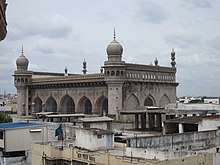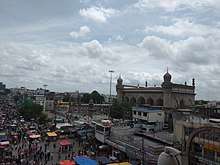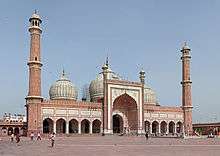Makkah Masjid, Hyderabad
Makkah Masjid or Mecca Masjid, is a congregational mosque in Hyderabad, India. It is one of the largest mosques in India with a capacity of 20,000. The mosque was built between the 16th and 17th centuries, and is a state-protected monument situated in the heart of the old city of Hyderabad, close to the historic landmarks of Charminar, Chowmahalla Palace and Laad Bazaar.
| Makkah Masjid | |
|---|---|
 | |
| Religion | |
| Affiliation | Islam |
| Ecclesiastical or organizational status | Mosque |
| Location | |
| Location | Hyderabad |
| State | Telangana |
| Country | India[1] |
| Geographic coordinates | 17.360305°N 78.473416°E |
| Architecture | |
| Style | Indo-Islamic architecture |
| Completed | 1694 |
| Specifications | |
| Capacity | 20,000 |
| Length | 67 m |
| Width | 54 m |
| Height (max) | 23 m |
| Materials | granite |
Muhammad Quli Qutb Shah, the fifth ruler of the Qutb Shahi dynasty, commissioned bricks to be made from the soil brought from Mecca, the holiest site of Islam, and used them in the construction of the central arch of the mosque, thus giving the mosque its name. It formed the centerpiece around which the city was planned by Muhammad Quli Qutb Shah.[2]
History and construction
Makkah Masjid was built during the reign of Muhammad Quli Qutb Shah, the fifth Qutb Shahi Sultan of Golconda (now Hyderabad). The three arched facades have been carved from a single piece of granite, which took five years to quarry. More than 8,000 workers were employed to build the mosque. Muhammad Quli Qutb Shah personally laid the foundation stone and constructed it. The construction was abandoned after the death of the Emperor.
Jean-Baptiste Tavernier, a French explorer, in his travelogue observed:
"It is about 50 years since they began to build a splendid pagoda in the town which will be the grandest in all India when it is completed. The size of the stone is the subject of special accomplishment, and that of a niche, which is its place for prayer, is an entire rock of such enormous size that they spent five years in quarrying it, and 500 to 600 men were employed continually on its work. It required still more time to roll it up on to conveyance by which they brought it to the pagoda; and they took 1400 oxen to draw it."[3]

The Nizams of Hyderabad (except for the first and last) are buried in the mosque premises.
Tombs
The entrance to the courtyard is one of the mosque's most striking features with a rectangular, arched, and canopied building that houses the marble graves of the Asaf Jahi dynasty rulers. This structure was created during the rule of the Asaf Jah rulers. It contains the tombs of all Asaf Jahi rulers except the 1st and the last Nizam, Mir Osman Ali Khan, who is buried in Judi Mosque opposite King Kothi Palace[6][7]
At both ends of this resting place for the Asaf Jahi's are two rectangular blocks with four minarets each. These minarets have elegant and circular balconies with low ornamental walls and arches. Above them is an octagonal inverted platter from which the rest of the minarets soar until arrested by a dome and a spire.[8]
References
- Google maps. "Location of Makkah Masjid". Google Maps. Retrieved 24 September 2013.
- "Mecca Mosque". Encyclopædia Britannica. Retrieved 3 November 2011.
- Jean-Baptiste Tavernier, Travels in India (English translation), Oxford University Press, Humphrey Milford, translated by Ball, London 1925 pg 205. Both volumes translated from Le Six Voyages of J. B. Tavernier (2 vols. 4to, Paris, 1676)
- "Bomb hits historic India mosque". BBC News Online. 18 May 2007.
- "HuJI ban takes no note of 'terror' role". Times of India. 8 August 2010.
- "Welcome to TCI".
- "50 years after Hyderabad Nizams death, kin say his contributions neglected". 24 February 2017.
- "Makkah masjid is dying! Does anyone in Hyderabad cares?? | Deccan Digest".
External links
| Wikimedia Commons has media related to Mecca Masjid, Hyderabad, India. |


